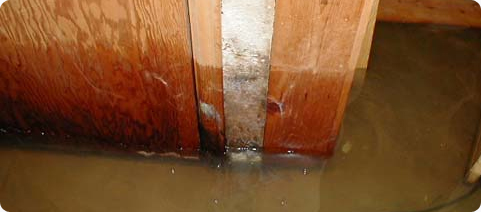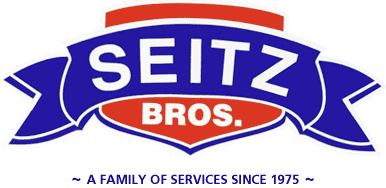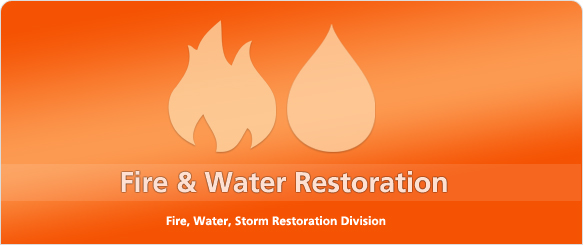Water Damage Prevention

Water damage can often be avoided with routine maintenance.
Early detection could mean the difference between a simple mop-up job and major construction repairs.
- Check for hidden leaks by turning off faucets, all water-using appliances, and not flushing toilets for one hour. Record the water meter reading. If the flow indicator (triangular or diamond-shaped rotating button) is spinning or the meter reading has changed while no water is being used, a leaking pipe may exist.
- Know where the main water shut off valve is located in your home and check it frequently to make sure it is operational.
Inside Your Home
Water leaks can happen anywhere in the house, but they occur most frequently in the kitchen, bathroom and laundry rooms.
Kitchen
- Dishwasher - Periodically check under the sink to see if the hose connection to the water supply line is secure and is not leaking. Check around the base of the dishwasher for evidence of leaks. Look for discolored, warped, or soft flooring materials or water damage to nearby cabinets.
- Refrigerator - If your refrigerator has an icemaker, check the hose connection to make sure it is securely attached to the water supply line. The wet spot you see on the floor near the refrigerator may be melted ice cubes or it may be a crimped icemaker line about to burst.
- Sink - Recaulk around sinks and pay attention to slow-draining pipes. This may indicate a partially blocked drain. Check the pipes under the sink for signs of water leaks.
Bathroom
- Showers and Bathtubs - Discoloration or soft areas around floors and walls near showers or bathtubs may be your first indication there is a leak. Check caulking at joints where the walls meet the floor or the bathtub looking for cracks or mold. If either is found, clean and remove loose material and apply new sealant. If the shower walls or floor are tiled, a leak may develop if there are cracks or missing areas of grout.
- Sinks - Check under the sink for signs of leaks from water supply lines or drainpipes.
- Toilets - Placing inappropriate objects or too much toilet paper in the bowl can accidentally clog toilets, especially low-flow toilets now required in homes. Hanging bowl deodorants are frequently the culprits. These objects can lodge deep in the plumbing system, and can block the line or create an obstruction that grease and other materials can cling to - eventually causing blockage. In addition, some chlorine tablet cleaners may corrode some of the internal components, eventually leading to a leak.
Laundry/Utility Room
- Washing Machine - Inspect washing machine hoses regularly for wetness around hose ends and signs of bulging, cracking or fraying. Replace the hose if a problem is found or every three to five years as part of a proactive maintenance program.
- Water Heater - Most water heaters last 10 to 15 years. Wet spots on the floor or a rusted tank may signal a problem. Hot water heaters should be installed on the lowest level of the home and always located next to a floor drain. If installed above or adjacent to finished spaces, the hot water heater should be placed inside a drain pan with the drain pan piped to the floor drain.
Basement
- Sump Pump - Sump pump systems assist in keeping unwanted water out of your home. Battery-operated back-up sump pumps can offer a degree of protection against power failure or failure of the primary pump. A generator can also be used to power the pump in case of a power failure. Test the sump pump before the start of each wet season to ensure it is in working order. Sump pumps are not intended to last more than 10 years and must have some components replaced or serviced within those 10 years.
Outside Your Home
- Leaking roofs, poor drainage, and clogged gutters and downspouts can lead to significant water damage inside your home.
General Tips
- Disconnect garden hoses from all spigots before the start of winter.
- Fill in any low spots around the house so water drains away from the foundation.
- Inspect caulking around windows and doors and replace as needed where cracked or deteriorated.
- Repaint wood siding as needed.
Roof
- Keep roof, valleys, gutters and downspouts free from buildup of leaves, twigs and other litter preventing proper drainage.
- Proper roof and eave ventilation may help extend the life of the roof by reducing the buildup of heat and moisture in the attic.
- Avoid walking on a roof to limit wear and tear. Only necessary repairs or inspections should warrant walking on the roof.
- Keep trees trimmed to prevent them from rubbing against the roof or from providing excessive shade.
Gutters/Downspouts
- Clean debris from your gutters and inspect them regularly.
- Consider purchasing gutter shields if your gutters frequently fill with debris.
- Downspouts should extend several feet away from the house to carry water away from the foundation.
As part of our water restoration service, we provide 3 convenient locations covering places like Allentown, Bethlehem and Easton at our Trexlertown location in the Lehigh Valley; or Scranton, Wilkes-Barre and Stroudsburg at our Tannersville office in the Poconos; and Hazleton, Reading, and Lancaster at our Tamaqua Headquarters in Eastern and Central Pa. We also service parts of New Jersey and New York. Call today to schedule an appointment and see why you are calling the best water restoration service in PA.





